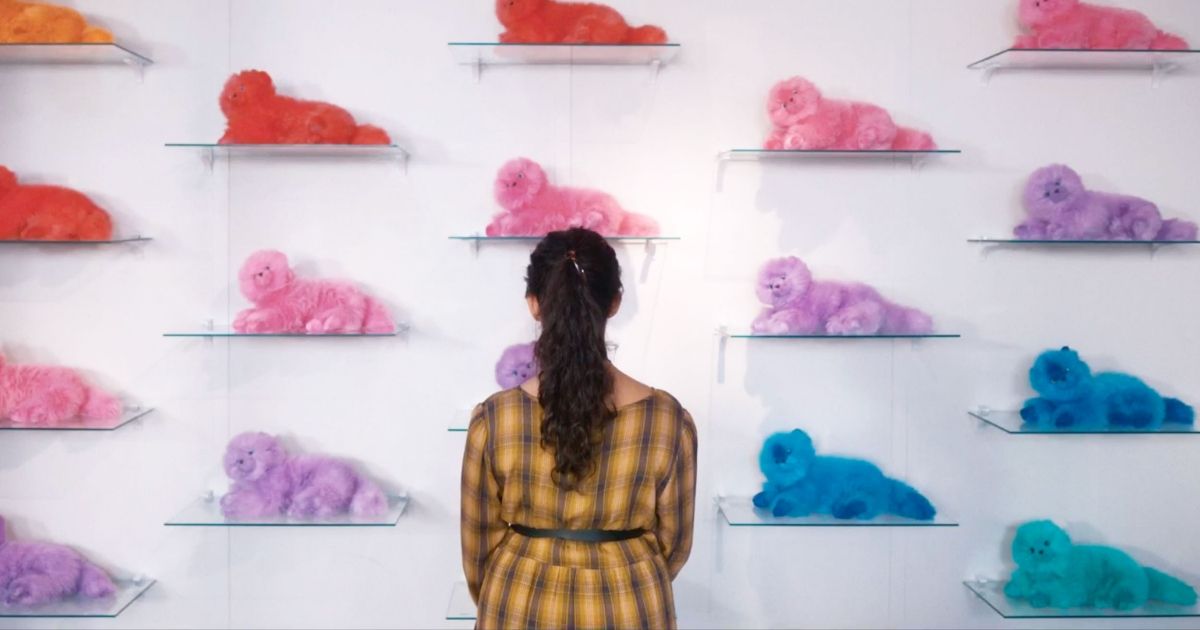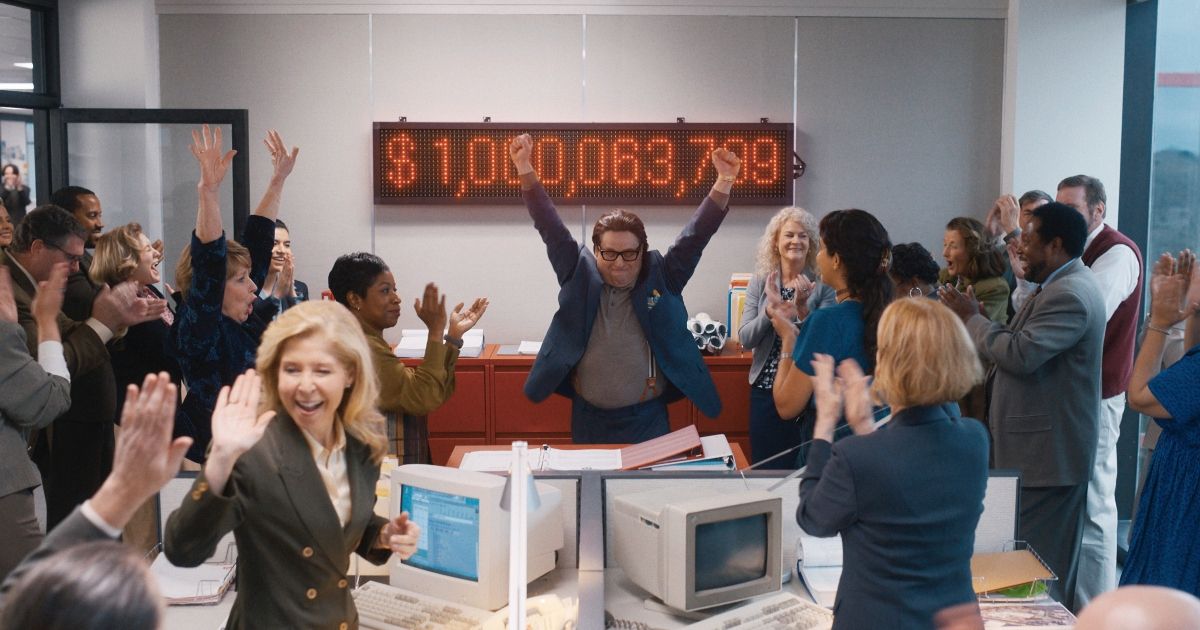What’s the big problem with disillusionment? I mean, who wants to live in illusionment?
That’s one of many great little lines from the new Apple Original, The Beanie Bubble, and it typifies one of the film’s main goals — to strip bare the bogus claims of pure meritocracy and lone genius that are so fundamental to inequality, exploitation, and the manipulation of capital. It’s a lot to cover in a movie about Beanie Babies.
And yet, The Beanie Bubble does an exceptional job of presenting the creation of the iconic stuffed collectible against the backdrop of these bigger themes. With a healthy dose of ’90s nostalgia, delightful humor from the excellent cast, and bold editing choices, the new film is extremely entertaining and very intelligent, thanks to filmmakers Kristin Gore and Damian Kulash. It’s also arguably the best example of the boom in product-based films this year — Air, Tetris, Blackberry, Flamin’ Hot, and even an upcoming movie about freakin’ Pop-Tarts. Except this time, as opposed to most of those other films, the evolution of corporate America and the nature of capitalism are actually explored with thoughtful, probing dynamism.
It doesn’t necessarily have to be that intellectual, though. The Beanie Bubble also works as a fun biopic, casting a fantastic Zach Galifianakis as Ty Warner, most commonly recognized with his name encased in a read heart and spelled “ty.” The film follows him from 1983, when his father dies, to the year 2000, when he’s on top of the world, unaware of the tiny apocalypse headed his way. The Beanie Bubble oscillates between multiple time periods, structured by three different women who helped define not only Ty but Beanie Babies themselves, but who never received the credit they deserved.
As such, it’s a portrait of the cyclical nature of economic inequality, and a damning (but darling) look at the women behind the scenes of a famous man.
The Beanie Bubble Pops
After a brief, intertwining bit of voiceover narration from the three women (played by Elizabeth Banks, Sarah Snook, and Geraldine Viswanathan), The Beanie Bubble begins with one of the best title sequences of the year. Inspired by an actual event in which a semi-truck carrying boxes upon boxes of Beanie Babies toppled over on a busy highway and scores of drivers pulled over to grab what they could, the sequence is a slow-motion ballet of colorful chaos, greed, and absurdity. Set to The Cure’s great “Plainsong,” it certainly sets a mood.
From there, the film dives straight into Ty Warner’s life. He meets his future business partner and lover Robbie (a stand-out Banks) in 1983. A decade later he is introduced to an intern who will become his future creative consultant (Viswanathan) and a mother who will become his fiancée (Snook). With them, he’ll start a massive stuffed animal empire, develop the idea of Beanie Babies, become one of the first companies to utilize the internet, expand internationally, and suffer the costs of success.
The Beanie Bubble wastes no time playing hopscotch with their lives and timelines, simultaneously chronicling the development of Ty, Inc. and the creation of Beanie Babies. While the non-linear format may confuse or frustrate some viewers, Jane Rizzo’s editing is rather ingenious, linking different timelines together with audiovisual cues. It brings to mind the underrated 2005 masterpiece, Stay.
The Beanie Bubble is never boring as a result, catapulting itself through 17 years with aplomb, documenting the glory days and nightmare finish to Ty’s relationships with these three women. He’s a kind and very giving person, but usually just when he wants something, and he takes the great ideas from people (even children) and claims them as his own for a profit and an ego boost. Thus, there’s an underlying structure to the film, thematically and visually connecting different periods of time, indicating that this is how Ty Warner works, no matter the year, no matter the person, and it’s getting worse.
Zach Galifianakis and Elizabeth Banks Steal the Film
Ty Warner is more than Ty Warner in The Beanie Bubble, though. His behavior is representative of much larger things, and he’s a kind of eccentric stand-in for patriarchy, capitalism, and the American dream all rolled up into one weird, funny package. How else to explain voiceover passages like this:
I never imagined just walking away from Ty. But once you do, man does it feel good. The thing about Ty is, he draws you in, wins your trust. When things get bumpy, you just think he’s complicated, a little damaged. You wanna keep believing in him. Until you just can’t anymore.
While it is certainly a (generally unconventional) biopic of Warner, The Beanie Bubble uses its protagonist as an avatar for all those illusions of meritocracy, trickle-down economics, and ‘lone American genius’ that is so often propagated by culture. Galifianakis is both warm and aloof, funny and cruel, and ultimately paradoxical in his performance, which is perfect for what he’s standing in for — the absurdity of late-stage capitalism. It’s a grand performance, even if the character itself probably has bigger shoes than anyone could fill, but Galifianakis is entirely game.
The rest of the performances are admirable as well, especially Banks, who can stand toe-to-toe with the most confident of comedians. She has layers of heartbreak sandwiched between ambition and optimism, and when it all gets squished, she’s wonderful at being both crushed and resilient. Viswanathan is her usual sarcastic self, and Snook is good, but the Succession star unfortunately has less to do than anyone else. Still, she exhibits some masterfully composed melancholy in the scenes in which Ty lets her down.
The Adorable, Awful American Dream
Kulash, of the pop-rock band OK Go, brings the same visual and rhythmic panache that he brought to his viral music videos, and directs The Beanie Bubble with colorful charm. Gore, his wife, injects deep meaning into the film; the subtle use of ’90s politics seems uncannily authentic coming from Al Gore’s daughter. She’s a strong writer, and even if the film relies a bit too heavily upon voiceover, she directs everything in one irrevocable direction that’s both melancholic but ultimately liberating.
The Beanie Bubble has a clever trajectory that leads to some eye-opening realizations for anyone not so well-versed in the ways that big business and ‘male geniuses’ marginalize people along racial, gender, and class lines. As one character says, “You don’t know you’re playing a rigged game. But if it’s any comfort, at least you had the privilege of believing in the first place.”
The American dream is on full display in The Beanie Bubble. It’s colorful, exciting, and fun. But it’s also heartbreaking, capricious, and untrustworthy. It’s initially inspiring, and eventually defeating. It’s usually a white guy in a suit, no matter how quirky he is.
According to The Beanie Bubble, the dream is personified in Ty Warner, and how he seduces and exploits the women in his orbit. It’s absurd, like someone going wild over a little Beanie Baby and spending hundreds of dollars on a tiny bear or plush ghost. It’s funny-ha-ha, but also sad enough to make you chuckle. It’s a dream or it’s a nightmare. It’s not real. Wake up.
The Beanie Bubble will premiere in select theaters on July 21 and globally on Apple TV+ on July 28, 2023.
This story originally appeared on Movieweb


